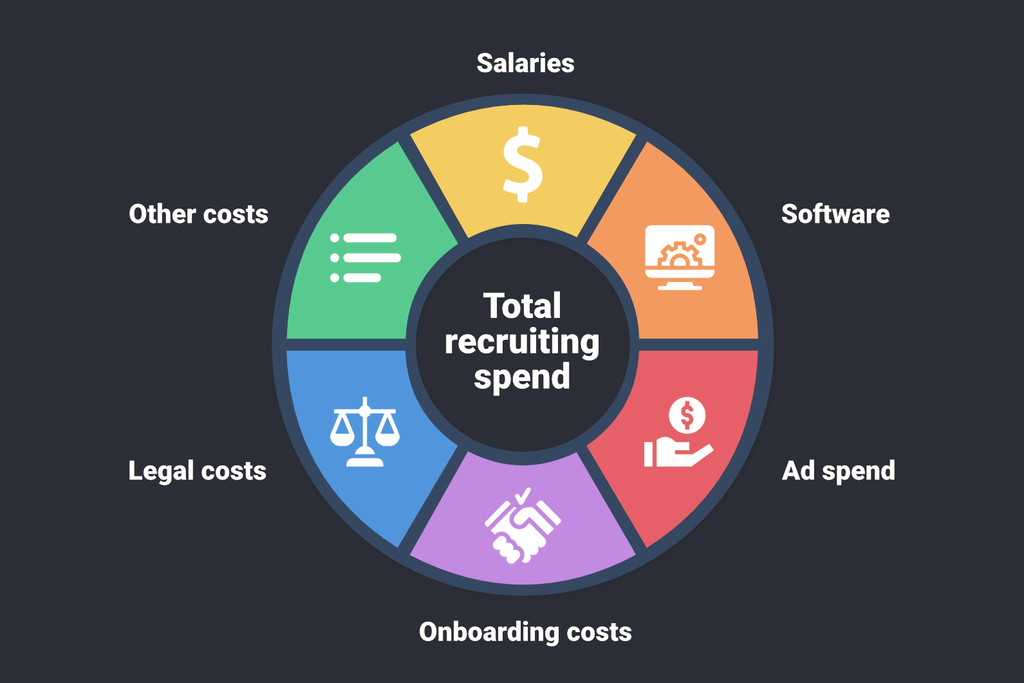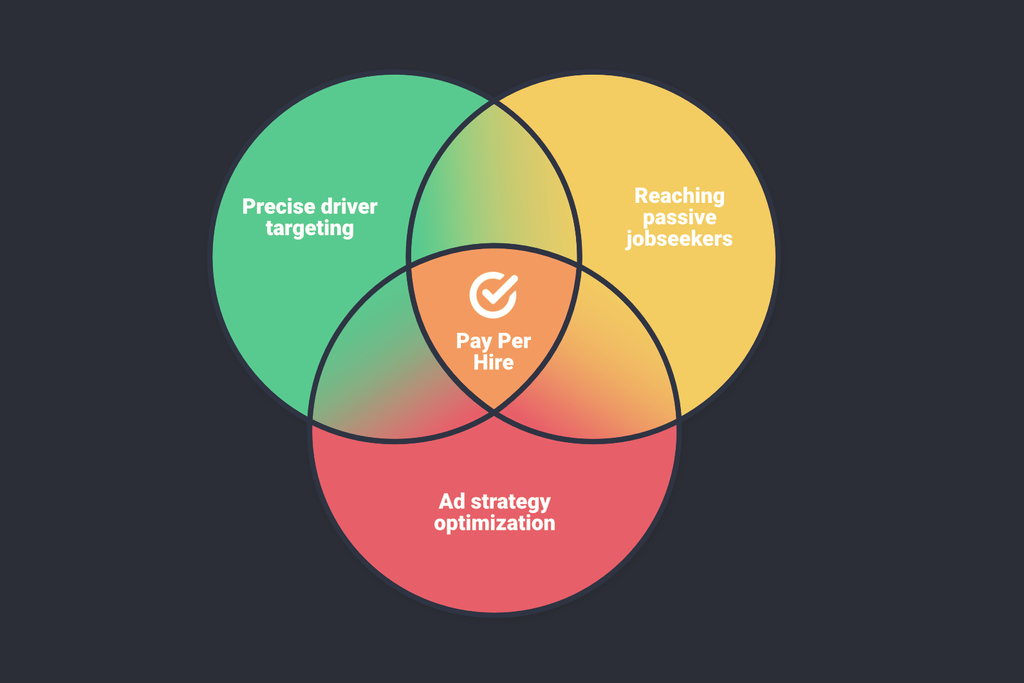How much does it cost to hire a driver?
If the numbers outlined in the study published by the Upper Great Plains Transportation Institute (UGPTI) in 2001 are to be taken as any indication, the average cost to hire a Class A dry van driver is $12,692.
The range of hiring costs presented in the limited study is stark, ranging from $3,457 to $31,954 per driver as the lower and upper ranges of companies surveyed. Note: figures have been adjusted for inflation.
The study took into account the subjective and sometimes incomplete data provided by 15 trucking companies to arrive at those figures.
The UGPTI did not take into account:
- Cost of advertising
- Cost of staff time
- Cost of hiring technology subscriptions
Surely the growth of the internet and online advertising since 2001 would have had a big impact on hiring cost. On the one hand, you have a new avenue for spending in the form of online advertising. Being heard and seen in a new and competitive space could lead to additional costs for many.
On the other hand, increasing the bandwidth of exposure to your jobs and company could lead to decreased spending due to increased efficiency. In addition, new hiring technologies could save valuable recruitment time. Without hard data, I can only speculate.
What else has changed since 2001? The emergence of driver recruiting software some years later would surely impact cost per hire dramatically. Some of the biggest and most well known software solutions are still prohibitively expensive to many smaller carriers, and may have contributed to an increase in overall recruiting costs for their customers. It’s hard to say for sure.
Many sources online state the findings in this study as fact. Clearly, it’s not that simple.
Given the technological and industry changes that have taken place since 2001, it’s safe to assume that these figures need revising. In fact, this may be a great opportunity create a new survey of our own and set the record straight.
What’s the true cost of hiring a driver?
Understanding general figures is important to keep your company’s hiring performance in context. However, the limited data available in the public domain can only go so far in helping you improve your recruitment process.
The real value comes in understanding what your company’s costs are. Getting your cost per hire (CPH) down to a precise figure is vital if you are to make recruiting improvements in the future.
The CPH metric is by no means the ultimate figure that determines your recruitment success. There’s a lot to account for including churn rate, retention, and more. We’ll touch on that another time.
If you aren't actively tracking your cost per hire, here’s a simple way to do it:
- Define a time period - for better accuracy, go for a year or a quarter. The longer the time period, the more accurate your CPH.
- Calculate all costs spent directly and indirectly on recruitment - this includes salaries, software, ad campaigns, onboarding costs, legal costs, etc.
- Take the sum of all costs in that time period and divide it by the number of hires you’ve made. That’s your cost per hire.

The more precise you get with what you consider recruiting costs, the better your final accuracy will be.
Pro tip: Calculating staff time can be hard if your company is too small to have dedicated full time recruiters, or if job responsibilities are divided up unconventionally. If that’s the case, you should aim to approximate the amount of time your staff spends on recruiting related activities in a day or week. Turn that approximation into a percentage indicating time spent on recruitment in the given time period. Then, use that percentage to arrive at the final time cost of recruiting.
Your CPH is an indication of the quality of your jobs, the efficiency of your recruitment department, as well as factors that are outside of your control. Still, as any growing and competitive business, you should use your CPH to identify areas of improvement in your recruiting process.
But what about the things outside of your control that negatively affect your CPH?
What comes to mind when you think ‘outside of your control’? Probably the economy and the driver shortage.
Many carriers struggle to receive the quantity and quality of applications needed to hire drivers at the needed rate and keep their trucks full. This leads to a cascade of inefficiency that increases recruitment expenditure and in turn drives CPH sky high. Let’s talk about that.
The driver shortage and quality vs quantity
The American Trucking Association’s driver shortage report from 2019 contains a lot of what you need to know about the driver shortage. It’s full of insights that can help you better navigate and come out on top in a brutal landscape where competition for skilled drivers is everything.
I want to draw attention to one of the main points that stuck out to me when reading the report - the section talking about driver lead quantity vs quality.
The report claims that carriers perceive the driver shortage to be greater than it is due to low applicant quality. Trucking companies have strict hiring restrictions because of a need to be safe and compliant, and are restricted by their insurance companies and government regulations.
These strict hiring requirements mean that most applications end up in the trash, and lead quality ultimately becomes top priority.
Here’s the thing: All available means at your disposal to advertise your job and fill your trucks capitalize on giving you quantity, not quality.
It doesn’t matter where you choose to advertise — everyone wants you to pay for leads, not hires.
Worse yet, you may end up paying for ad campaigns that can get you exposure, but cannot even guarantee quantity.
What happens then is that companies that struggle to get the needed applications end up seeing their cost per applicant go up dramatically. This increases their eventual CPH to the point that many carriers may choose to discount paid advertising altogether. That would be unwise.
It’s all about the hire
Paying for leads is flawed unless your ultimate cost per lead multiplied by your applicants per hire is less than a flat and comfortable fee. You’ll never have the guarantee that you can replicate that result consistently.
To illustrate just how much money is wasted on average, we got this quote from our director of business development & industry veteran, Jeff Martin. He shares his experience from his previous employment at trucking SaaS companies:
“On average, we saw that it cost 1,600 per hired driver JUST in advertising. The overhead is a bigger issue as costs pile up on top of costs, onboarding etc. That 1,600 figure is as high as it is simply because conversion rates we saw were so low. The average conversion rate I saw, that is to say applicants turning into hires, was 5 - 7 %. The way you contract these pricing models is that they’re all about paying on the front end, which is why the costs end up so high. Now, at YouCruit, we want to turn that model around and only do business with companies that we can help.”
— Jeff Martin on average advertising cost and conversion rate per hire
It’s clear that paying on the front end costs money. The only guarantee in place with these models is that you will overpay.
Why we want our customers to pay per hire
Over the last few years, we have tested many candidate sourcing options for our customers. We’ve dabbled in ad campaigns that provide leads for a set fee and even pricing models where carriers paid only for qualified drivers.
The big realization came later. We couldn’t keep charging for leads, we needed to charge for what’s truly important for our customers - the hire.
The reason we are able to let our customers pay one flat fee per driver hired comes down to three things:
- Targeting the right drivers - Over the last few years, we’ve drastically improved how we target drivers in specific hiring areas.
- Targeting passive job seekers - We target drivers online that aren’t actively looking for work, but are open to new opportunities. This is more valuable than just getting jobs seen on job boards.
- We take care of ad strategy & optimization - When you pay per hired driver, you don’t need to worry about where your money is going. We take care of ad spend and optimization so you can spend that time on hiring.

Paying per hire at a reasonable rate is a big promise and a big idea that seems to resonate with our customers. Dozens of companies are signing up each week for the promise of paying only once they fill their truck and onboard a new driver. It’s easy to see why.
Paying per hire can decrease your overall recruiting costs
Since paying per hire is strictly results-based, it eliminates the fluctuations and uncertainties of paying for leads, and comes out cheaper overall. The advertising cost per hire we offer our customers is competitively priced to be less than half of what average ad expenditure is at companies that frequently pay to advertise their positions online.
Paying per hire with YouCruit also means getting all of your candidates delivered digitally, where you can sort and move them through your hiring stages.
Direct messaging drivers leads to quicker response times, which in turn leads to higher hiring conversions.
Collaborating with your team in a digital environment also lets you split up your workload more efficiently and save time and money in the process.
Retain, grow, and thrive after the hire is made
The tail end of the phrase recruitment and retention is retention. This should be the main focus of your company long term, always. It is what will save the most money long term and provide the most consistent results.
There’s a lot more to say about retention, both in the form of insider insights and hard data. We promise to keep delivering new posts and insights on retention and other big recruitment topics as time goes on.
For now, here’s some more light reading containing big ideas about recruitment and retention:
How to Grow Your Trucking Business in a Driver Shortage - A post that shares industry proven insights to help you grow and retain in a tough industry.
How Attractive Job Ads Help Successful Carriers Hire More Drivers - Even though your pay and home time are the first things that catch a driver’s eye, the rest of your ad still matters. After all, it’s not just about your job, it’s about how you present it. But how do you know if your ad is as good as it can be?
How Driver Recruiters Use Speed to Boost Their Hires - Truck driver recruiters are 90% more likely to hire a driver if they contact them within 5 minutes of receiving an application. That sounds crazy, right? Read more to find out why it isn't.